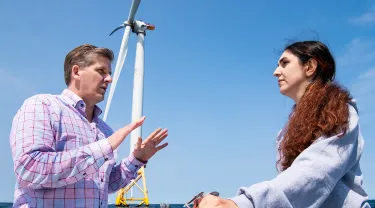Offshore wind power could provide all the electrical power needed by the U.S. Northeast, with the potential for thousands of extremely large wind turbines located offshore. But one of the biggest hurdles to creating that reality is getting the wind power from offshore generation points to the power grid on land.
Overcoming that hurdle is both an engineering and a political challenge—one that Tufts students and faculty are in the midst of efforts to solve. Their work has the potential to generate thousands of new jobs and fuel a massive infrastructure effort not seen since the New Deal in the 1930s.
Eric Hines, professor of the practice and Kentaro Tsutsumi Faculty Fellow in the Department of Civil and Environmental Engineering at Tufts School of Engineering, helps lead this effort, working at the interface of technology and policy to develop systems-level design concepts for offshore wind farms.
The best solution, Hines said, would be to construct hardened and resilient tunnels with high-quality cables while limiting the number of on-land locations that connect to the turbines through the tunnels.
One issue with that approach is designing a system that will allow engineers to plug more turbines into one onshore location in such a way that the country isn’t short-circuited. This extraordinarily complex issue requires engineers to think differently and to change the design of electricity substations by up to a ten-fold magnitude, Hines said.
In addition, he noted, it’s critical for federal, state, and regional public entities—as well as the private sector—to work directly with the coastal communities that will host the connectors. Those communities must trust that they’ll see significant economic investment, lots of jobs, the removal and cleanup of dirty power plants, and the restoration of wetlands—but what they will not see are cables.
Once these features are put into place, offshore wind farms, in combination with solar energy, will go a huge way toward diminishing the U.S.’s reliance on fossil fuels, Hines explained, and the resulting energy will be far cleaner.
“If, as a society, we do this right,” said Hines, “we have the potential to simultaneously save the planet, create healthier communities, and create tens or even hundreds of thousands of new, high-paying jobs.”
Pictured above: Eric Hines and Nasim Partovi mehr, a doctoral student in Civil and Environmental Engineering, visit the wind turbine farm near Block Island
